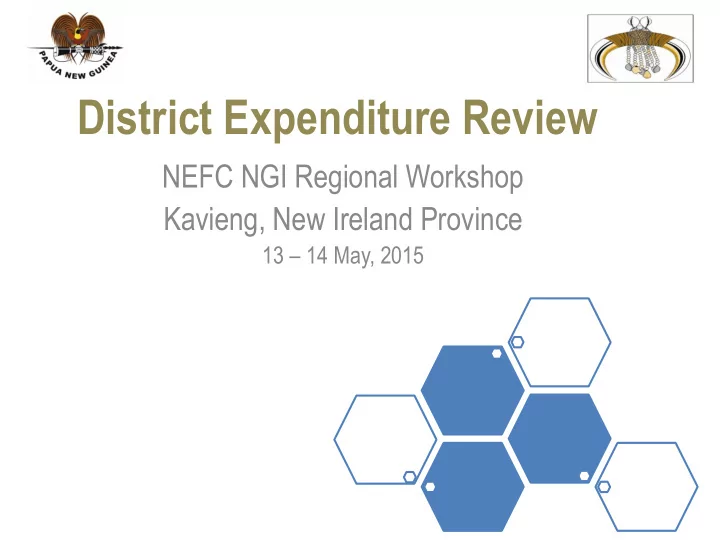

District Expenditure Review NEFC NGI Regional Workshop Kavieng, New Ireland Province 13 – 14 May, 2015
Outline • Overview • Methodology • Objective of DER • Key findings of the report • Recommendation • Progressive Update of the report • The next step?
What is the District Expenditure Review (DER)? • Joint study by the National Economic & Fiscal Commission (NEFC) and Department of Implementation and Rural Development (DIRD) • Review of capital expenditure and recurrent expenditure of four districts in 2013 • This study was initiated by NEFC CEO/Chairman Mr Hohora Suve and DIRD Acting Secretary Mr Paul Sai’i
Information source used in this study and its scoping and limitation We use the following sources; • PGAS expenditure data - 200 Series - 700 Series • DSIP Acquittals report • DIMS survey data Information used in this study exclude the following; • Direct facility funding • Funding on service delivery by churches, non-governmental agencies
Selecting the Districts The initial scope of this study is to review expenditures for six (6) Districts; • Kokopo (East New Britain) Usino Bundi (Madang) • Henganofi (Eastern Highlands) • • Wapenamanda (Enga) South Fly (Western) • • Rai Coast (Madang) However, the number of districts were reduced to four during the late stage of the study by the heads of the two agencies due to; • Quality of the data – there is no electronic copy of PGAS data available The criteria used to select the districts was based on the first six (6) districts who submitted their 2013 DSIP Acquittals to DIRD
Methodology Data Collection • PGAS Data collected by NEFC in 2014 from the district treasuries • DSIP acquittals provided by districts to DIRD on annual basis • DIMS data available from 2011 DIMS survey and another follow up survey conducted last year by DIRD, NEFC, World Vision, PM’s Department and UNICEF Analysis • DIRD analysed the DSIP acquittals data • DIRD/UNICEF analysed the DIMS survey data • NEFC analysed the PGAS expenditure data Report Write Up NEFC and DIRD jointly did the write up of the report based on the findings • from the analysis
Objective of DER • Conduct an evident based review of capital and recurrent expenditure trend at the district level • Provide a comparative expenditure analysis of variations between the districts • Provide an analysis of expenditure trend against the MTDS sectors • Determine the current relationship between recurrent and capital expenditure; and • Determine the effectiveness of district financial management systems and processes
Key Issues in the report • Inadequate recurrent funding to support maintenance and upkeep costs In 2013, almost 80% of expenditure at the district level were categorised as - capital spending while over 20% as recurrent expenditure Over 30% of the total capital expenditure was spent on operational and - maintenance costs alone Basic Development Recurrent Capital & Project Operational & Service Expenditure Expenditure Costs Maintenance Costs Delivery
Issues Cont…. • Financial Management reporting systems and processes are weak Inconsistency in applying expenditure codes between districts - Districts are not submitting PGAS data to the DoF - • Present SIP acquittal system is onerous and needs to be streamlined Less than 50% of Provinces, 89% of Districts and only 32% of LLGs had submitted - their acquittals for 2013 The system is further undermined when DoF releases next tranche of SIP funds - before the previous acquittals are being appraised and reviewed by DIRD
Major Source of Spending by Item Code Item # Item description Amount % Category Description Amount % 225 Construction, Improvement and Renovation 13,429,253 35% Capital Expenditure 30,738,556 79% 135 Other operational expenses 8,961,865 23% Recurrent Goods & Services 7,960,764 21% 143 Grant Transfers to Public Authority 4,286,773 11% 128 Routine Maintenance Expenses 4,092,675 11% 224 Plant, Equipment and Machinery 2,612,800 7% 222 Purchase of Vehicles 1,702,000 4% 123 Office Materials and Supplies 628,013 2% 144 Grants Transfer to Indiv. & Non-profit 624,900 2% 112 Wages 458,510 1% 125 Transport and Fuel 373,465 1% Other Item Codes 1,529,066 4% Total spending from recurrent & capital 38,699,320 100% Total spending from recurrent & capital 38,699,320 100%
Expenditure Overview Expenditure Overview 12,000,000 10,000,000 8,000,000 Kina in Millions (K) Goods & Services Personal Emoluments 6,000,000 Capital & Projects 4,000,000 2,000,000 -
With high expenditures in this sector, has it achieve service delivery outcomes? Is high goods & services expenditure on administration achieving service delivery or Expenditure Overview should these funds disperse to priority sectors to carry out key 12,000,000 service delivery activities? 10,000,000 Is expenditure in primary production and village 8,000,000 Kina in Millions (K) court sectors enough or is Goods & Services there are need to increase expenditure on these two Personal Emoluments 6,000,000 key sectors? Capital & Projects 4,000,000 2,000,000 - Why is that service delivery grants are still spent on wages with larger amount under administration?
Other Key Issues in the report • Key intergovernmental financing principles advocated by the NEFC • District Service Improvement Program (DSIP) and Acquittals • District Development Authority (DDA) • Expenditure on Enabling Environment for service delivery - Water Supply and Sanitation - Family Health Programs - Environmental Health Issues
Recommendations This joint study has identify that; • Intergovernmental financing system can be more integrated for effective equity funding system • Frontline agencies responsible for service delivery must continue to work together; - Develop effective financial systems and processes • Spending at sub-national levels should focus more on Sustaining existing public services and not merely on development of new public services
Progressive update • Preliminary draft is complete and editing is in progress for; - Verification and double checking the data set that are used - Verifying the issues highlighted to make sure they are in line with the objectives of this study
The next step? • Submit the report to NEFC CEO/Chairman and DIRD Acting Secretary for reading and comments • Publication
Kalaro!!!!
Recommend
More recommend